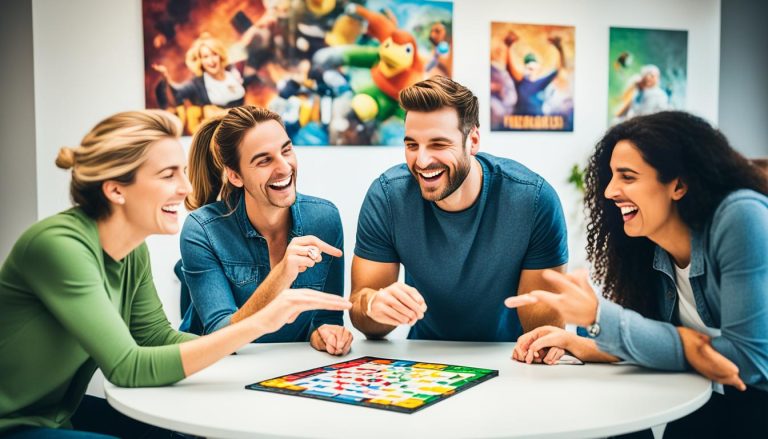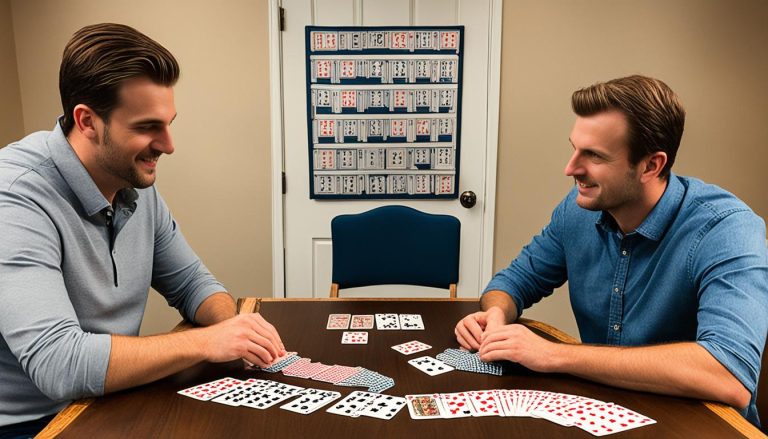Monopoly Junior, designed as an approachable version of the classic Monopoly game, invites children to embark on an exhilarating and educational journey through Monopoly Town. This simplified yet engaging board game features child-friendly locations, making it a delightful way for kids to engage with money and learn basic financial principles.
The primary objective is to amass the most cash while other players face bankruptcy. The Monopoly Junior set, distinguished by Hasbro’s trademark quality, includes a gameboard, tokens, Chance cards, Sold signs, banknotes, a die, character cards, and a game guide. Tailored for ages five and up, the game accommodates 2 to 4 players, demanding adult assembly due to small parts posing a potential choking hazard.
Perfect for family fun and kids game night, Monopoly Junior fosters an environment where young players can develop their understanding of finance and strategy while having a blast.
Unboxing Monopoly Junior: Components and Setup
Unboxing Monopoly Junior reveals an array of components that set the stage for a fun-filled game setup experience. Exciting visuals and child-friendly pieces are designed to enchant younger players.
Game Components
Inside the Monopoly Junior box, players will find everything needed for gameplay. These Monopoly Junior components include a colourful gameboard, four Junior tokens, Chance cards, Sold signs, Monopoly banknotes, a single die, and Who’s Your Token? Character cards. Each piece is crafted to ensure an engaging and interactive experience for kids.
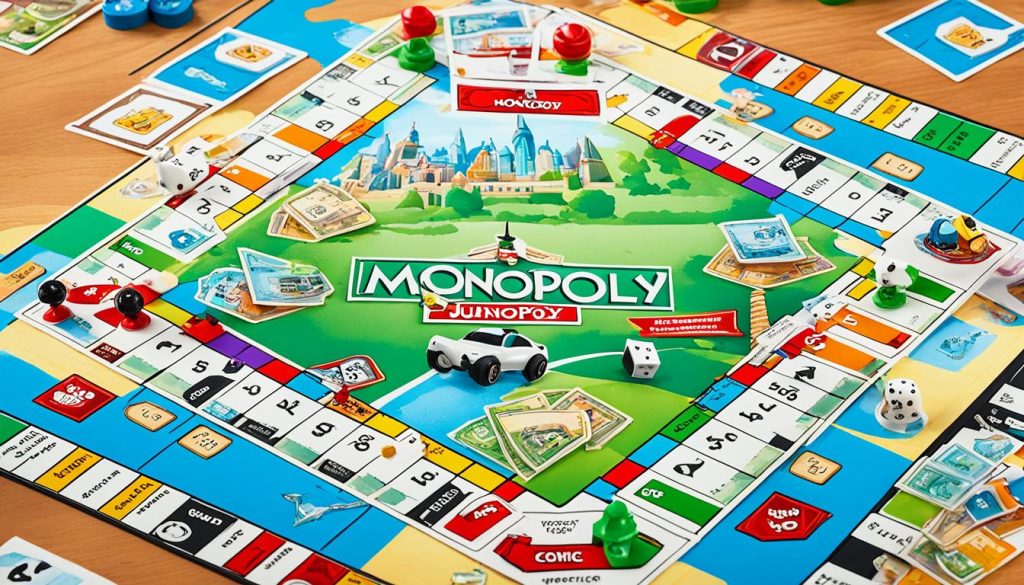
Initial Setup
Once all the Monopoly Junior components are unboxed, the game setup process is straightforward and quick, making it easy for children and parents. Begin by placing the gameboard centrally. Each player selects their character token and corresponding Sold signs. Next, shuffle the Chance cards and place them on the designated spot on the board. One player should be chosen to act as the banker, responsible for managing the game’s finances. This simple Monopoly Junior guide ensures everyone is ready for the gaming adventure ahead.
- Place the gameboard in the centre.
- Select character tokens and Sold signs.
- Shuffle and place Chance cards.
- Appoint the banker to manage finances.
The initial game setup is designed to be uncomplicated, paving the way for a seamless transition into the exciting world of Monopoly Junior.
Starting the Game: Monopoly Junior Rules
Understanding how to play Monopoly Junior begins with knowing how to choose a token and the role of the banker. These steps are essential for an exciting gaming experience, especially when figuring out how to play Monopoly Junior with 2 players.
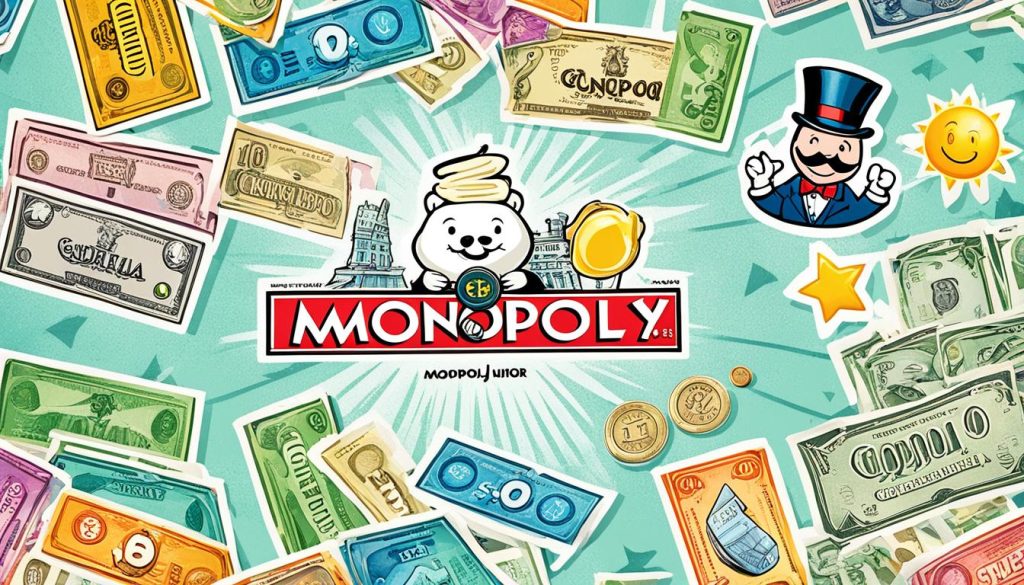
Selecting Your Token
Each player starts by selecting a token that represents them on the board. The game offers charming options such as Little Scottie, Little T-Rex, Little Penguin, and the Toy Ducky. This element adds a personal touch to the playing experience and makes it more engaging for children.
Starting Cash and Role of the Banker
The starting cash in Monopoly Junior is an integral part of setting the stage for the game. The total differs depending on the number of players:
- 20 M1 banknotes for 2 players
- 18 M1 banknotes for 3 players
- 16 M1 banknotes for 4 players
This allocation of Monopoly Junior rules money aids in establishing the economic foundation necessary for gameplay. The banker’s duties are critical, entailing the distribution of starting cash, managing monetary transactions, paying rent, and dealing with Chance card outcomes.
By understanding these key aspects, players ensure a structured and fair start to their gaming adventure. These elements provide a basic yet vital framework on how to play Monopoly Junior, making the game enjoyable for children and adults alike.
Understanding Monopoly Junior Gameplay
Monopoly Junior gameplay offers a delightful mix of chance and strategy, perfect for engaging young minds. To start, each player takes turns to roll the die, moving their token around the board according to the number shown on the die. This basic mechanism ensures clarity and a straightforward approach, allowing kids to focus on the thrilling aspects of the game.
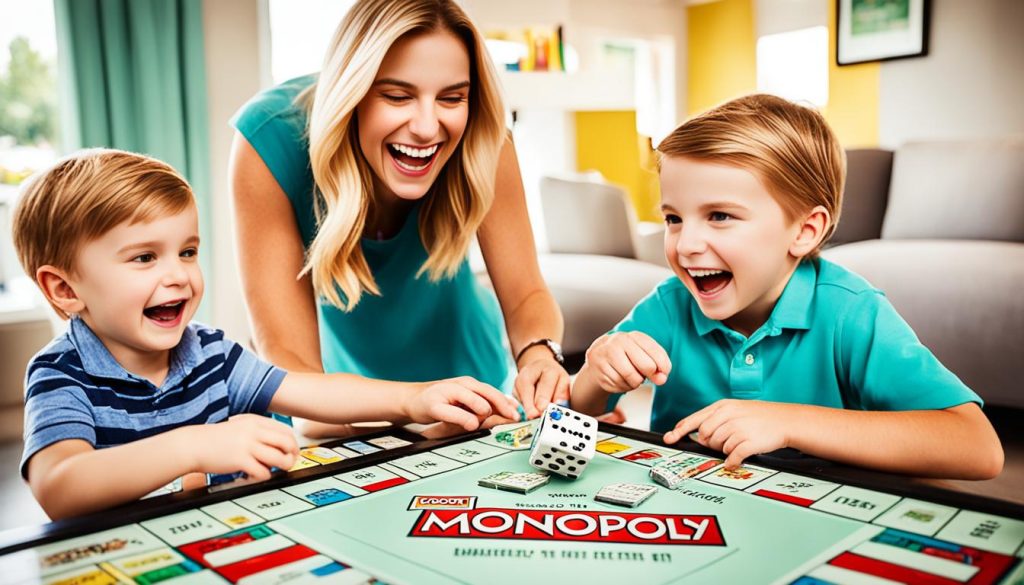
Rolling the Die and Moving
The roll of the die is crucial in determining the player’s fate each turn. As the token moves forward, it may land on vacant properties, properties owned by others, or special board spaces. This aspect of Monopoly Junior gameplay employs a mix of luck and anticipation, making each roll an exciting moment for the players.
Buying Properties and Placing Sold Signs
When a player’s token lands on an unowned property, they have the opportunity to purchase it with their Monopoly money. Successfully buying a property allows them to place their Sold sign on it, marking their ownership. This play strategy not only reinforces children’s comprehension of financial transactions but also introduces them to the basics of property investment. Balancing the luck of rolling the die with the play strategy of acquiring properties, Monopoly Junior gameplay is designed to be both educational and entertaining.
How to Play Monopoly Junior?
Monopoly Junior is a simplified, captivating game that offers a delightful introduction to the world of property trading. Understanding the core steps and rules is essential to mastering the game. Here’s a comprehensive guide for you.
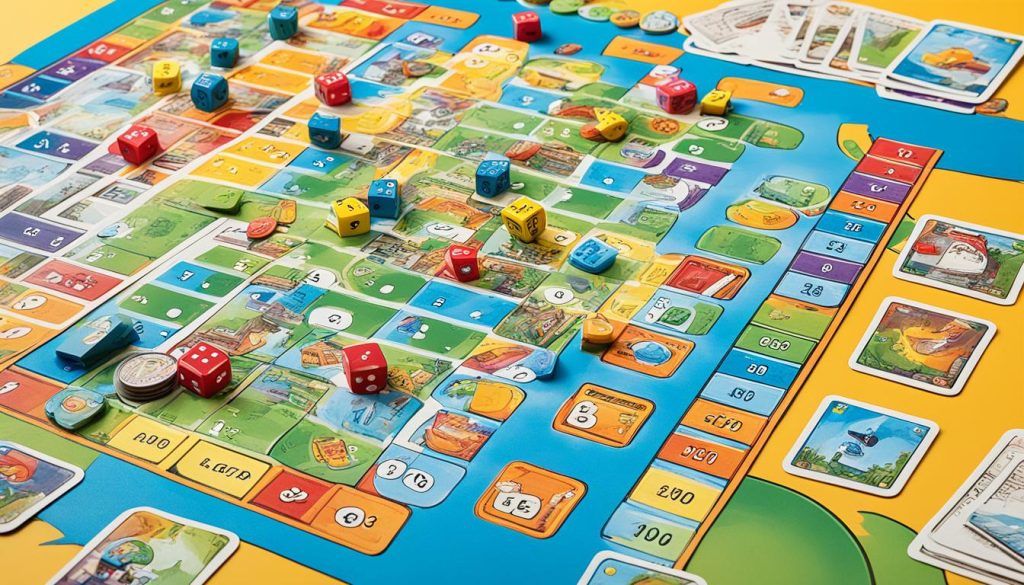
Landing on Properties
When a player’s token lands on an unowned property, the player has the chance to buy it using Monopoly money. If the property is already owned, the player must pay rent to the owner. This encourages strategic decision-making and forward planning.
Paying Rent
If you land on a property that another player owns, you must pay rent equal to the property’s value. Should a player own all properties of the same colour, the rent amount is doubled. This Monopoly Junior rule ensures constant interaction and competitive play among participants.
Passing Go and Collecting Monopoly Money
One of the key steps in Monopoly Junior is collecting Monopoly money as you pass the GO space. Each time a player passes GO, they receive a specific sum from the bank. This step is crucial for keeping the game dynamic and allowing players to plan their strategy effectively.
- Roll the die and move your token.
- Land on a property and decide whether to buy it.
- Pay rent if the property is owned by another player.
- Collect Monopoly money upon passing the GO space.
Following this step-by-step guide on how to play Monopoly Junior ensures smoother gameplay, while adhering to the Monopoly Junior rules and efficiently collecting Monopoly money paves the way to success in this engaging board game designed for young minds.
Special Spaces on the Board
Monopoly Junior enriches its gameplay by incorporating various special spaces on the board that can affect the game’s dynamics. These spaces add an extra layer of excitement and strategy, ensuring every turn is unpredictable and engaging.
Chance Spaces
Chance Spaces are pivotal in Monopoly Junior. When a player lands on a Chance Space, they draw a card from the Chance deck which can either be beneficial or detrimental to their progress. These cards might award cash, direct a player to move to a different position on the board, or impose fines, adding an element of surprise to the otherwise structured gameplay. Understanding these board game rules and the potential outcomes of Chance Spaces is crucial for formulating a winning strategy.
Go to Jail and Just Visiting
Landing on the Go to Jail space immediately sends the player’s token to the Jail space, where they miss a turn unless they can roll a double, pay a fee, or produce a ‘Get Out of Jail Free’ card from the Chance deck. In contrast, the Just Visiting space is benign, allowing players to rest without any implications, which is clearly outlined in the Monopoly Junior instructions. Knowing the difference between these spaces can influence game tactics significantly.
Free Parking
The Free Parking space is a safe haven for players. Unlike other spaces, landing on Free Parking does not require any payments or allow any transactions. It simply provides a moment of respite within the high-paced nature of the game. The presence of Free Parking introduces a welcome pause and can be an opportunity for players to strategise their next moves given the board game rules and overall situation of their game.
Winning the Game: Ending and Determining the Winner
In Monopoly Junior, a well-devised strategy is crucial to prevent bankruptcy and achieve victory. By applying a sound Monopoly Junior winning strategy, players can maximise their chances of success. The conclusion of the game is reached when a player is unable to continue buying properties or paying rent.
Avoiding Bankruptcy
An essential part of the Monopoly Junior winning strategy is avoiding bankruptcy. Players should be mindful of their expenditures and investments. Smart property purchases and effective rent collections are pivotal in maintaining a healthy cash flow, thereby evading financial ruin.
Count Cash and Properties
Once a player hits bankruptcy, it is time to determine the winner. Each player must count their total cash and the value of their properties. This combined total decides the ultimate victor. Should there be a tie in cash, the total value of properties owned will be the deciding factor in determining the winner.
| Step | Action | Purpose |
|---|---|---|
| 1 | Monitor Cash Flow | Helps in avoiding bankruptcy |
| 2 | Buy Strategic Properties | Maximises rent collection |
| 3 | Count Cash | First step to determine the winner |
| 4 | Calculate Property Values | Used in the event of a cash tie |
| 5 | Combine Totals | Final step in determining the winner |
To conclude, implementing a robust Monopoly Junior winning strategy is integral to navigating through the myriad challenges posed by the game and finally determining the winner based on a well-calculated assessment of resources.
Monopoly Junior Strategies and Tips
Mastering Monopoly Junior requires both strategic thinking and a bit of luck. Here are some essential Monopoly Junior strategies and tips to help you outshine your competition.
Secure Colour Sets: One effective strategy is to aim for property sets of the same colour. Not only does this bolster your rent collection, but it also deters others from completing their sets, providing a dual advantage in your favour.
Frequently Landed-on Properties: Investing in properties that are commonly landed on can generate substantial rent income. Monitor the board carefully to identify these prime locations and purchase them early in the game.
Timing Use of Chance Cards: Managing your Chance cards effectively can significantly influence your success. Hold onto beneficial cards, such as ‘Get Out of Jail Free’, until a crucial moment, and only utilise them when it can make a substantial difference in your game progression.
Avoiding Bankruptcy: Financial prudence is key. Be cautious with your spending and always keep a reserve of Monopoly money for emergencies, such as paying high rents or unexpected fines.
By integrating these Monopoly Junior strategies and tips, you can improve your gameplay and increase your chances of winning this exciting board game. Remember, the balance of assertive acquisition and financial caution can steer you towards victory.
Educational Benefits of Playing Monopoly Junior
Monopoly Junior transcends being merely a game, evolving into an invaluable learning tool. As children engage with the intricate structure, they naturally develop numeracy skills, facilitated by managing money and calculating change.
Moreover, notions of critical thinking and strategic planning are cultivated as players navigate through decisions surrounding property acquisitions and the unpredictable outcomes of Chance cards. These interactions provide young minds with an experiential understanding of basic economic concepts such as investment and asset management.
Additionally, Monopoly Junior nurtures negotiation skills which are essential for social interactions. The necessity for turn-taking also instils patience, further enhancing the game’s educational benefits. Learning how to play Monopoly Junior can significantly contribute to Children’s fundamental cognitive and social development.
| Key Educational Areas | Skills Developed | Monopoly Junior Elements |
|---|---|---|
| Numeracy | Money management, Change calculation | Monopoly banknotes, Property purchases |
| Critical Thinking | Strategic planning, Decision making | Chance cards, Property investment |
| Economic Concepts | Investment, Asset accumulation | Property trading, Wealth management |
| Social Skills | Negotiation, Patience | Turn-taking, Interacting with opponents |
Ultimately, educational benefits like these elevate Monopoly Junior to more than just a pastime, underpinning its value in early learning environments. Understanding how to play Monopoly Junior seamlessly introduces these concepts, making learning engaging and effective.
Conclusion
Playing Monopoly Junior extends beyond sheer amusement; it incorporates elements of competition and learning, making it a prime choice for introducing children to the fundamentals of property trading and financial management. This delightful game, set within the vibrant world of Monopoly Town, is fashioned with simplified rules that ensure a smooth entry into the realm of board games for young participants.
Monopoly Junior’s accessibility for beginners is paralleled by the strategic depth that keeps gameplay engaging over time. From managing finances to strategic acquisitions, players are encouraged to hone their decision-making skills while enjoying the dynamic and interactive nature of the game. These aspects make it an excellent tool for both educational purposes and family bonding moments.
For families and young players in the United Kingdom, Monopoly Junior is more than just a pastime—it’s an investment in educational fun. With its easy-to-understand mechanics and potential for varied strategies, this game truly stands out. Whether you aim to foster a love for board games, nurture numeracy skills, or simply enjoy a spirited family game night, the Monopoly Junior guide ensures that every game session is both enjoyable and enlightening.
FAQ
How many players can play Monopoly Junior?
Monopoly Junior is designed for 2 to 4 players, making it ideal for small family gatherings or kids’ game nights.
What is the recommended age for playing Monopoly Junior?
Monopoly Junior is recommended for children aged 5 and up.
How much money do you start with on Monopoly Junior?
Starting cash varies based on the number of players: 20 M1 banknotes for 2 players, 18 M1 banknotes for 3 players, and 16 M1 banknotes for 4 players.
What currency do you get in Monopoly Junior?
The currency used in Monopoly Junior is M1 banknotes, a simplified version of the traditional Monopoly money tailored for younger players.
Can Monopoly Junior be played with 2 players?
Yes, Monopoly Junior can be played with 2 players. Both players start with 20 M1 banknotes each.




